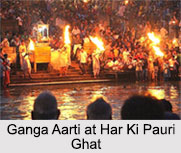 Ganga Aarti is generally performed in a form of light lamps with candles and flowers that`s floated down in Ganga River. The offering is made to the Goddess Ganga, goddess of the most holy river in India. Ganga Aarti is performed on a daily basis in evening by a group of priests at the Dasaswamedh Ghat.
Ganga Aarti is generally performed in a form of light lamps with candles and flowers that`s floated down in Ganga River. The offering is made to the Goddess Ganga, goddess of the most holy river in India. Ganga Aarti is performed on a daily basis in evening by a group of priests at the Dasaswamedh Ghat.
Ganga Aarti is performed in the places like Haridwar, Rishikesh, and Varanasi, where numerable lighted `Diya` or lamps are floated on the waves of River Ganga. It is a spiritual prayer that takes place at the bank of the sacred river Ganga at the "Har Ki Pauri" ghat in Haridwar.
Legend of Ganga Aarti
According to Hindu Shastras, River Ganga is imagined as a Goddess, who was originated from the Himalayas and then took shelter on the locks of Lord Shiva. King Bhagiratha rescued Ganga and brought her to the earth. Ganga is born out of lotus feet of Lord Vishnu and is famous as a stream of unpolluted water. She is sacred and repository of all virtues. Lord Shiva`s locks are the place for Ganga. She is the destroyer of all three kinds of afflictions- physical, mental and providential. It is very difficult to say when the tradition of Ganga Aarti started. Nevertheless, the Ganga Aarti at "Har Ki Pauri" was started by Pundit Madan Mohan Malviya in 1910s.
Rituals of Ganga Aarti
Ganga Aarti takes place facing the river. The lamps are lit and circled around by the pandits (Hindu priests) in a clockwise way, accompanied by the songs in praise of Mother Ganga. The idea is that the lamps get the power of the deity. After the ritual is complete, devotees cup their hands over the flame and raise their palms to their forehead in order to get the Goddess`s refinement and blessing.
 All the priests who have to perform the Ganga Aarti, wear the same cloth, the "dhoti" and "kurta" which is tightly bind with a long towel. First they make preparation of Ganga Aarti by making a set of the five raised planks, a multi tiered oil lamp, an idol of the Goddess Ganga, flowers, a conch shell, a big and heavy brass lamp having a snake hood at the edge. Ritual of Ganga Aarti is performed by the students of the Vedas and Upanishads which is lead by the head priest of the "Gangotri Seva Samiti". A group of young priests starts Aarti in a well organized way by having a lighting lamp in their hand, starting a rhythmic chant of mantras. Idol is normally carried out in "palkhi" by pundits which they put on the platform of ghat near River Ganga. The whole occasion takes around 45 minutes. The Aarti takes place at 6.45 p.m. in the evening after the sunset for around 45 minutes at the Dashashwamedh ghat in Varanasi.
All the priests who have to perform the Ganga Aarti, wear the same cloth, the "dhoti" and "kurta" which is tightly bind with a long towel. First they make preparation of Ganga Aarti by making a set of the five raised planks, a multi tiered oil lamp, an idol of the Goddess Ganga, flowers, a conch shell, a big and heavy brass lamp having a snake hood at the edge. Ritual of Ganga Aarti is performed by the students of the Vedas and Upanishads which is lead by the head priest of the "Gangotri Seva Samiti". A group of young priests starts Aarti in a well organized way by having a lighting lamp in their hand, starting a rhythmic chant of mantras. Idol is normally carried out in "palkhi" by pundits which they put on the platform of ghat near River Ganga. The whole occasion takes around 45 minutes. The Aarti takes place at 6.45 p.m. in the evening after the sunset for around 45 minutes at the Dashashwamedh ghat in Varanasi.
Hymns of Ganga Aarti
The Ganga aarti is sung as follows-
Arti ganga maiya, man jai sursari maiya
Bhav-varidhi-uddharini atihi sudradh naiya, man Jai....
Hari pada-padam-prasuta vimal varidhara,
Brahmadeva Bhagirathi shuchi punyagara, man Jai
Shankar-jata-viharini, hanoi trya tapa,
Sagar-putra-gana-tarini harani sakal papai man Jai...
Ganga Ganga jo jana uchcharat mukha son,
Dur desh man sthit bhi turat tarat sukh son, man Jai...
Mrit ki asthi tanik tuv jal dhara pavai,
So jan pavan hokar param dham javai, man Jai
Tav tatvasi taruvar, jal thal char prani
Pakshi-pashu-patang gati pavai nirvani, man Jai
Matu, daya mai kijai dinan par daya
Prabhu pad padma milakar Hari lijai maya, man Jai.
Bringing in tourists and devotees from all over the world, Ganga Aarti is a ceremony of light and sound where the priests execute prayers with bowls of fire and the ringing of the temple bells.









